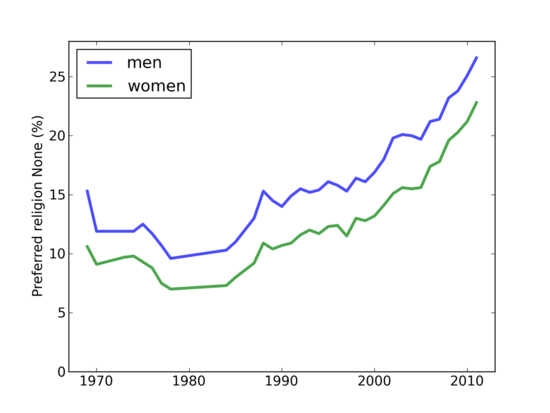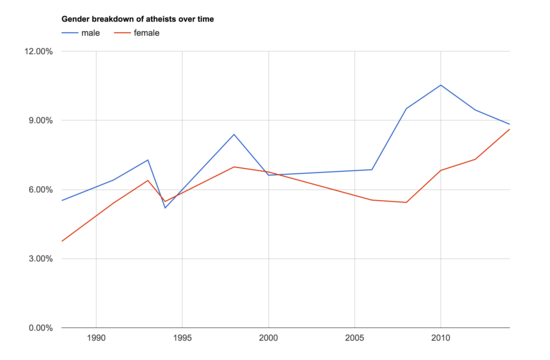Atheism By Gender Over Time |
August 13th, 2015 |
| gender |
One place to look is the General Social Survey (GSS). This is a set of responses to survey questions asked since 1972, and while some questions aren't asked every year there is a lot of overalap. This makes it a good fit for seeing how people's views have changed over time.
Starting in 1988 the GSS asked:
Please look at this card and tell me which statement comes closest to expressing what you believe about God.Responses of "don't know" and "no answer" were also possible. I coded people as "skeptic" if they answered with one of the first two responses: people who don't believe in God or believe there's no way to find out. Graphing these as a percentage of the population of each gender we get:
- I don't believe in God.
- I don't know whether there is a God and I don't believe there is any way to find out.
- I don't believe in a personal God, but I do believe in a Higher Power of some kind.
- I find myself believing in God some of the time, but not at others.
- While I have doubts, I feel that I do believe in God.
- I know God really exists and I have no doubts about it.
The sample sizes are pretty small, but the 2006-2012 data is kind of strange. The gender ratio at the 2000 survey was near 50%, and in 2014 it was again near 50%, but in 2006, 2008, 2010, and 2012 it was much more uneven. I'm really not sure what happened here.
Another place to look for something similar is the CIRP survey, including tens of thousands of students at hundreds of colleges. Students are asked what their current religious preference is. Allen Downey graphed the percentage of men and women answering "None" over time:

(Note that this isn't quite the question I'd like, since someone can be non-religious but still believe in God, but it's close.)
This is much less noisy than the GSS data, enough that the way the curves track each other is kind of suspicious. The number of respondents is much higher, though, so that could explain it. It does look like the gender ratio is becoming much more balanced, from 41% female in the late 70s to 47% female in the latest data. [1]
I don't have any hard conclusions to draw from all this, I just wanted to see what the numbers looked like over time.
[1] Downey looks at the gender gap in percentage points over time and
concludes the opposite: "the gender gap seems to be growing". But
if you have a group that's X% female and you double the number of
members as a fraction of the larger population you'll see a
doubling of the gender gap in percentage points without a change
in the gender ratio. The gender ratio in the CIRP data is
becoming more balanced, and the slightly increasing gap in
percentage points is just an artifact of growing numbers.
Comment via: google plus, facebook, substack
